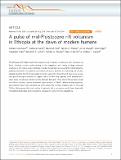Files in this item
A pulse of mid-Pleistocene rift volcanism in Ethiopia at the dawn of modern humans
Item metadata
| dc.contributor.author | Hutchison, William | |
| dc.contributor.author | Fusillo, Raffaella | |
| dc.contributor.author | Pyle, David M. | |
| dc.contributor.author | Mather, Tamsin A. | |
| dc.contributor.author | Blundy, Jon D. | |
| dc.contributor.author | Biggs, Juliet | |
| dc.contributor.author | Yirgu, Gezahegn | |
| dc.contributor.author | Cohen, Benjamin E. | |
| dc.contributor.author | Brooker, Richard A. | |
| dc.contributor.author | Barfod, Dan N. | |
| dc.contributor.author | Calvert, Andrew T. | |
| dc.date.accessioned | 2016-11-03T13:30:13Z | |
| dc.date.available | 2016-11-03T13:30:13Z | |
| dc.date.issued | 2016-10-18 | |
| dc.identifier | 247346771 | |
| dc.identifier | 34e0d7e9-7c67-4f35-97d9-d11e959eb69b | |
| dc.identifier | 84992107522 | |
| dc.identifier | 000385538000001 | |
| dc.identifier.citation | Hutchison , W , Fusillo , R , Pyle , D M , Mather , T A , Blundy , J D , Biggs , J , Yirgu , G , Cohen , B E , Brooker , R A , Barfod , D N & Calvert , A T 2016 , ' A pulse of mid-Pleistocene rift volcanism in Ethiopia at the dawn of modern humans ' , Nature Communications , vol. 7 , 13192 . https://doi.org/10.1038/ncomms13192 | en |
| dc.identifier.issn | 2041-1723 | |
| dc.identifier.uri | https://hdl.handle.net/10023/9757 | |
| dc.description | This work is a contribution to the Natural Environment Research Council (NERC) funded RiftVolc project (NE/L013932/1, Rift volcanism: past, present and future). W.H. was funded by NERC studentship, NE/J5000045/1 and a Boise Trust Fund from the Department of Zoology (University of Oxford). R.F. was funded through European Research Council Advanced Grant ‘CRITMAG’ to J. Blundy. | en |
| dc.description.abstract | The Ethiopian Rift Valley hosts the longest record of human co-existence with volcanoes on Earth, however, current understanding of the magnitude and timing of large explosive eruptions in this region is poor. Detailed records of volcanism are essential for interpreting the palaeoenvironments occupied by our hominin ancestors; and also for evaluating the volcanic hazards posed to the 10 million people currently living within this active rift zone. Here we use new geochronological evidence to suggest that a 200 km-long segment of rift experienced a major pulse of explosive volcanic activity between 320 and 170 ka. During this period, at least four distinct volcanic centres underwent large-volume (>10 km3) caldera-forming eruptions, and eruptive fluxes were elevated five times above the average eruption rate for the past 700 ka. We propose that such pulses of episodic silicic volcanism would have drastically remodelled landscapes and ecosystems occupied by early hominin populations. | |
| dc.format.extent | 12 | |
| dc.format.extent | 2163301 | |
| dc.language.iso | eng | |
| dc.relation.ispartof | Nature Communications | en |
| dc.subject | GE Environmental Sciences | en |
| dc.subject | Chemistry(all) | en |
| dc.subject | Biochemistry, Genetics and Molecular Biology(all) | en |
| dc.subject | Physics and Astronomy(all) | en |
| dc.subject | DAS | en |
| dc.subject.lcc | GE | en |
| dc.title | A pulse of mid-Pleistocene rift volcanism in Ethiopia at the dawn of modern humans | en |
| dc.type | Journal article | en |
| dc.contributor.institution | University of St Andrews. Earth and Environmental Sciences | en |
| dc.identifier.doi | https://doi.org/10.1038/ncomms13192 | |
| dc.description.status | Peer reviewed | en |
This item appears in the following Collection(s)
Items in the St Andrews Research Repository are protected by copyright, with all rights reserved, unless otherwise indicated.

